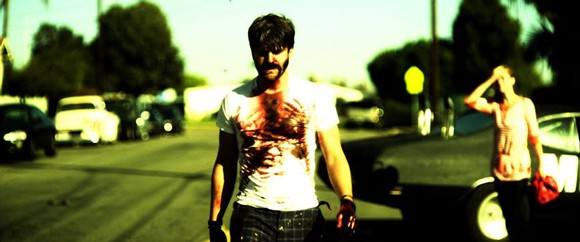
The post-apocalyptic aesthetic for cinema was defined in 1979’s Mad Max when Mel Gibson bowled through the Australian Outback scrounging for gasoline and water, taking no guff along the way. The look of his car, the DIY weaponry, and the punk rock-infused fashion sense created a legacy director George Miller probably did not imagine at the time of shooting.
The lasting effect can be seen in many places. Annually, Southern California plays host to Wasteland Weekend, where enthusiasts of the themes and styles exemplified in the Mad Max series get together and revel in the subculture Mel built. Undoubtedly, fans all over the world hold other events and represent in their own fashion. And while many big-to-normal budget movies have “borrowed” from the series (Waterworld, The Book of Eli, Doomsday), now a small independent feature getting plenty of buzz from the festival circuit shows off their love for the Road Warrior in Bellflower.
One thing not so obvious in its promotions is that the story isn’t actually set in, or headed to, a post-apocalyptic future. We’re rooted firmly in the present and instead of a sun-scorched desert full of bizarre bandits, things take place in Los Angeles amongst a small group of typical hipsters.
This film’s Max Rockatansky is Woodrow, played by writer/director/co-editor/producer Evan Glodell. Woodrow is content to spend his days trying to make a working flamethrower and dreaming of one day having a car named Medusa, decked out like that of his cinematic role model, so he can earn the self-imposed moniker of Lord Humongous. His best friend, Aidan (Tyler Dawson), shares his interest in preparing for a world drenched in anarchy and lawlessness and had it not been for the duo meeting Milly (Jessie Wiseman) and Courtney (Rebekah Brandes) in a bar one night, this probably would have just turned into a Discovery channel show about guys who like to build things. But they do all meet, and the fallout from this new grouping shapes the rest of the film.
Now, trying to describe Bellflower is a little like defining a color without referring to anything visual for context. It opens with a jumble of scenes from late in the film, implying an ominous end to the whole affair. However, the majority of the first hour is told linearly and plays out like a decently executed mumblecore romance a la 2007’s Quiet City, only with far more aimless protagonists.
Not knowing a single thing about the project beforehand, it was a happy surprise to follow Woodrow & Milly’s budding romance. Because of how sincere and natural the relationships and characters felt, and as a fan of the mumblecore genre, I even forgave the atrociously terrible visuals (a result of Glodell’s own hand-crafted camera rig, which created a blown out color palette heavy on yellows and blacks). And while none of the actors did anything especially impressive, their performances are not at fault for any of the film’s shortcomings either.
Of course, there was always this nagging doubt concerning the scenes shown at the beginning and the unfortunate reality is that once things start to devolve, the resulting shift in tone (and essentially genre) make for one of the most pretentious efforts of 2011 – even when considering The Tree of Life. While Sundance and SXSW audiences may have resonated with the production because of its indie nature and minuscule budget (around $17,000), the last 40 minutes of Bellflower feel like the bastard child of a Gregg Araki film, with even less coherence if that’s possible (and I like much of Araki’s work).
Not only do the sweet and charming aspects go swiftly out the window, but the characters also act in such unbalanced and unprepared manners that it’s nearly impossible to make the intellectual leap for the sake of following along. All of this is made worse because it’s quite clear that this was Glodell’s intentional doing. The simple, base violence – physical, sexual, and mental – only exacerbates the amateurish camera work and cinematography (fans would say avant-garde but obviously, I’m not in that camp). It creates an atmosphere where the last 40% of the film is exhausting to sit through because all appreciation for the story has gone far, far away.
I’ve read plenty of glowing reviews that extol Glodell’s effort for all of its inventiveness, and I get that, but merely presenting a cacophony of themes on a shoestring budget isn’t enough to earn my approval. If there was a way to only show minutes two to sixty-two, I’d happily recommend Bellflower to mumblecore aficionados, but considering the film as a whole, I’m afraid the result isn’t worth most people’s time and energy. Only those suffering from a gnawing curiosity need to seek this effort out.
GRADE: D+
Bellflower is rated: R for disturbing violence, some strong sexuality, nudity, pervasive language and some drug use.






